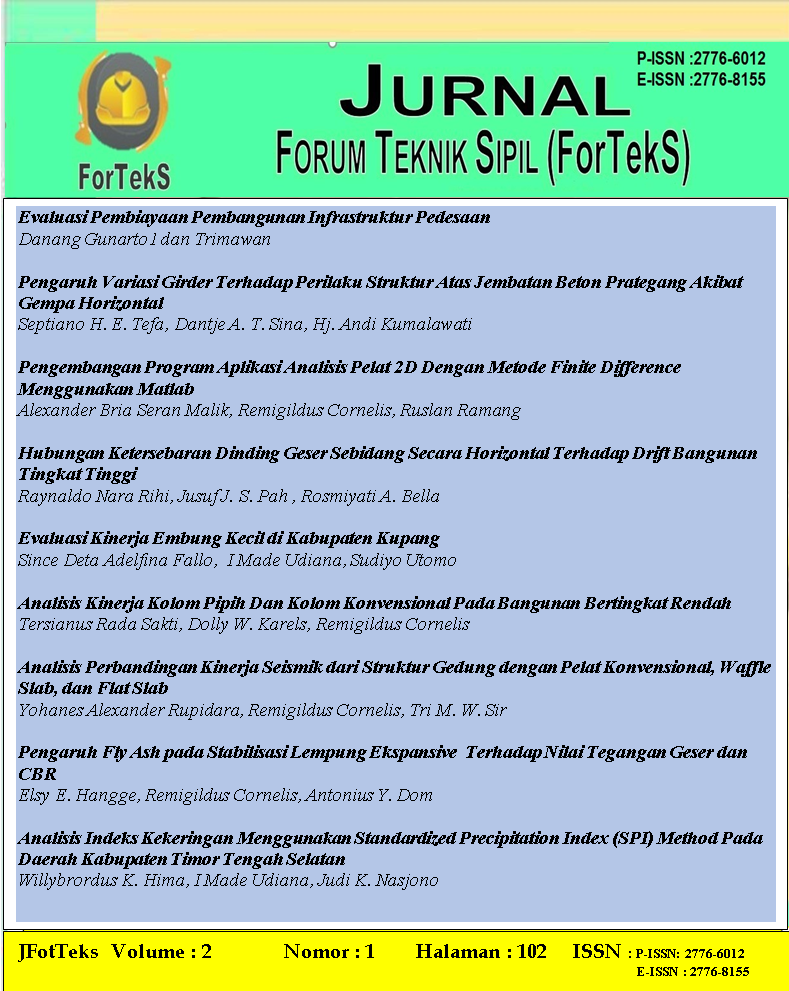Analisis Perbandingan Kinerja Seismik dari Struktur Gedung dengan Pelat Konvensional, Waffle Slab, dan Flat Slab
Comparative Analysis of Seismic Performance of Building Structures with Conventional Slab, Waffle Slab, and Flat Slab
Abstract
Indonesia is a country with high earthquake risk because it is located in the path of the most active earthquake in the world. It makes Indonesia situated in a region with a high earthquake intensity. The study aimed to determine the seismic performance levels of building structures with conventional slabs, waffle slabs, and flat slabs with the time history analysis method. There are three models of structures studied, namely building structures with conventional plates, building structures with waffle slabs, and building structures with flat slabs, with a 5-story structure system, where the longest and shortest span has the same size of 20 m and the height of each level 4 m. This study showed the largest displacement was 235.82 mm in building structures with waffle slabs and the smallest displacement was 146.49 mm in building structures with flat slabs. The largest drift is 0.012 on a building structure with a waffle slab, and the smallest drift is 0.007 on a building structure with a flat slab. The level of seismic performance produced from all three types of structures varies from immediate occupancy (IO) to damage control (DC).
Downloads
References
Applied Technology Council, ATC 40. (1996). Seismic Evaluation and Retrofit of Concrete Buildings. Redwood City, California, U.S.A.
Asroni, A. (2010). Balok dan Pelat Beton Bertulang. Yogyakarta: Graha Ilmu.
BSN. (2013). Persyaratan Beton Struktural untuk Bangunan Gedung (SNI 2847:2013). Jakarta : BSN.
BSN. (2017). Baja Tulangan Beton (SNI 2052:2017). Jakarta : BSN.
BSN. (2019). Tata Cara Perencanaan Ketahanan Gempa untuk Struktur Bangunan Gedung dan Nongedung (SNI 1726:2019). Jakarta : BSN.
Hassoun, M.N., & Al-Manaser, A. (2015). Structural Concrete: Theory and Design (6th ed.). New Jersey: John Wiley & Sons, Inc.
Hedge, R., Chethana, & Kumar, N. V. (2018). “Comparative Study on Seismic Analysis of Conventional Slab, Flat Slab, and Grid Slab System for a R.C Framed Structures.” International Research Journal of Engineering and Technology (IRJET), 5(09).
Nishanth, CH. L., Swaroop, Y. S., Jagarapu, D. C. K., & Jogi, P. K. (2020). “Analysis and Design of Commercial Building with Different Slab Arrangement Using Etabs.” Elsevier Ltd, 33, 700–704.
PPIUG. (1983). Peraturan Pembebanan Indonesia untuk Gedung. Bandung : Yayasan Lembaga Penyelidikan Masalah Bangunan.
Shaga, A. & Polisetty, S. (2016). “Seismic Performance of Flat Slab with Drop and Conventional Slab Structure.” International Journal of Latest Engineering Research and Applications (IJLERA), 1(09).
Tavio & Wijaya, U. (2018). Desain Rekayasa Gempa Berbasis Kinerja. Yogyakarta: ANDI.
Widodo. (2001). Respons Dinamik Struktur Elastik. Jogjakarta: UII Press.
Wight, J.K., & MacGregor, J.G. (2012). Reinforced Concrete: Mechanics and Design (6th ed.). New Jersey: Pearson Education, Inc.
Jurnal ForTeks memberikan akses terbuka terhadap siapapun agar informasi dan temuan pada artikel tersebut bermanfaat bagi semua orang. Semua artikel jurnal ini dapat diakses dan diunduh secara gratis, tanpa dipungut biaya sesuai dengan lincense creative comons yang digunakan
ForTeks : Jurnal Forum Komunikasi Teknik Sipil is licensed under a Creative Commons Attribution-ShareAlike 4.0 International License

 Yohanes Alexander Rupidara(1)
Yohanes Alexander Rupidara(1)

















